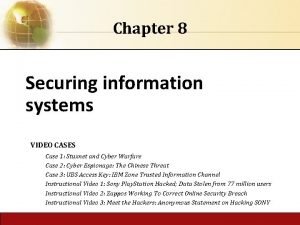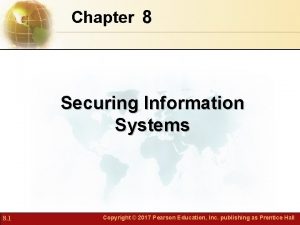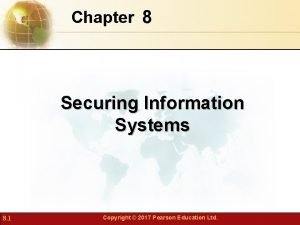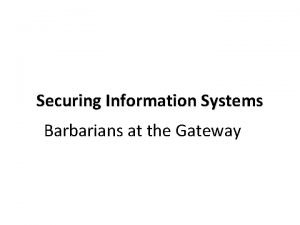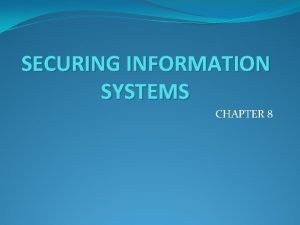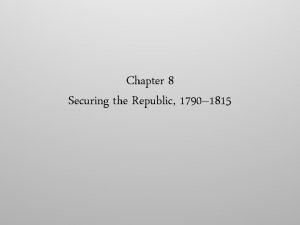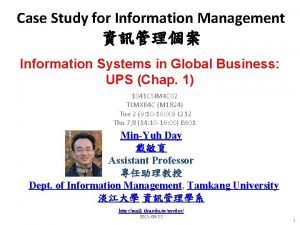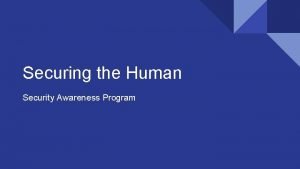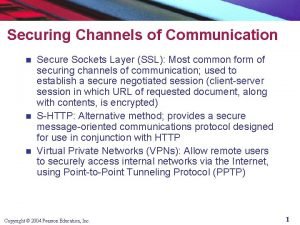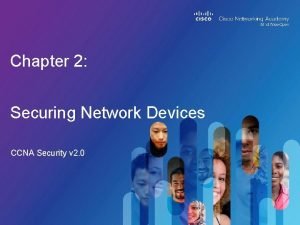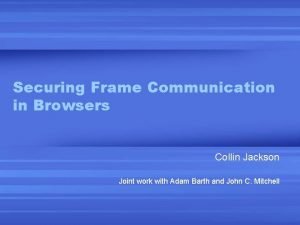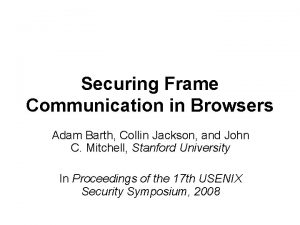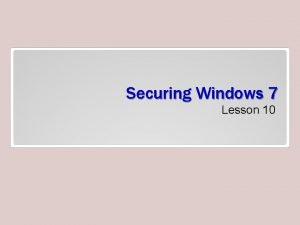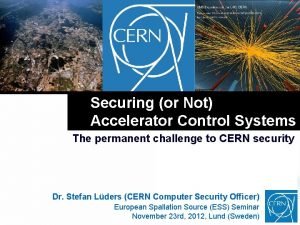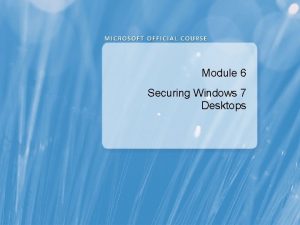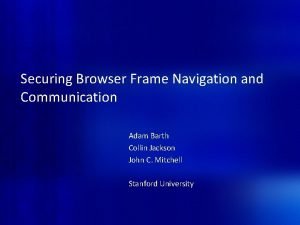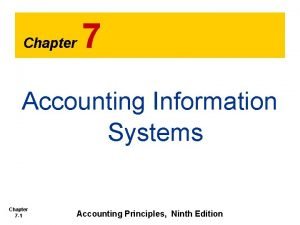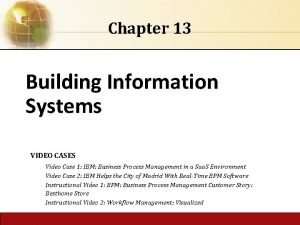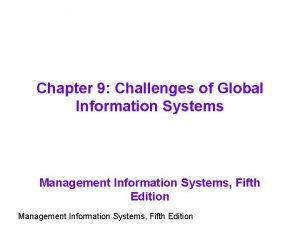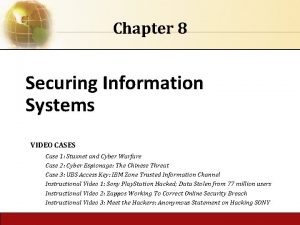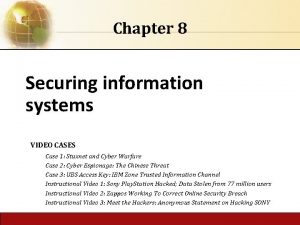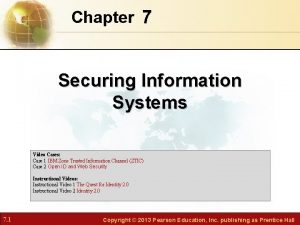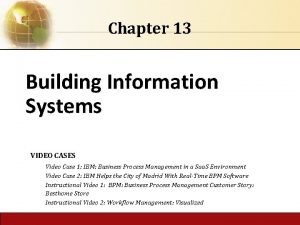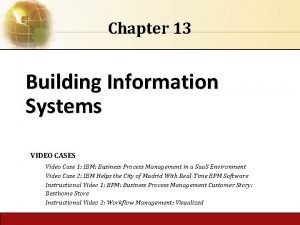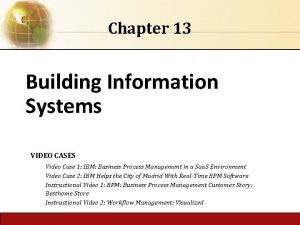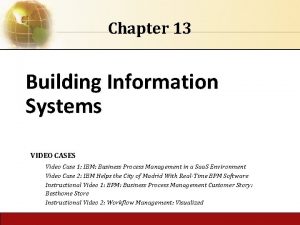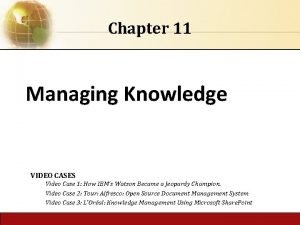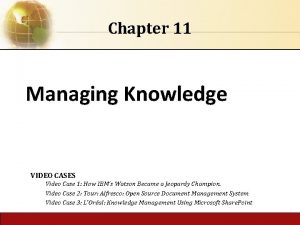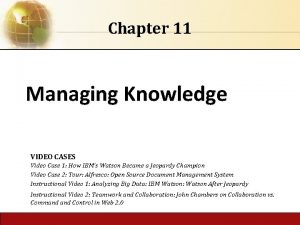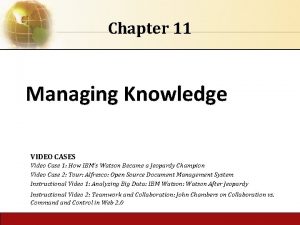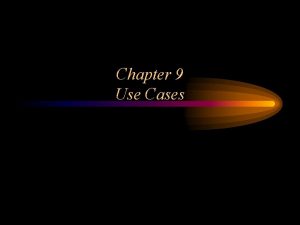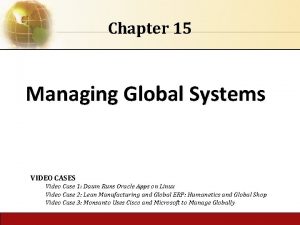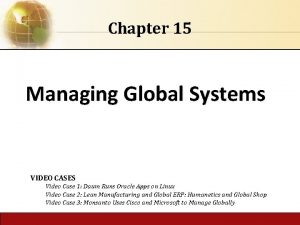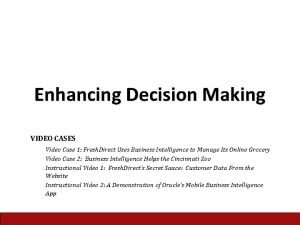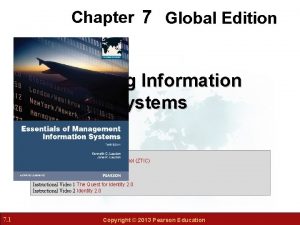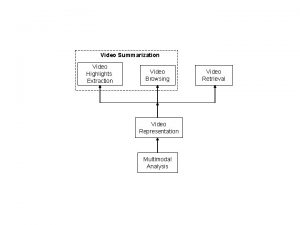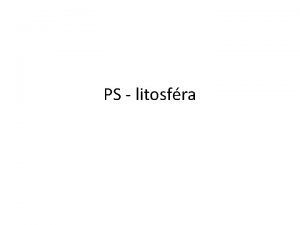Chapter 8 Securing Information Systems VIDEO CASES Case

































- Slides: 33

Chapter 8 Securing Information Systems VIDEO CASES Case 1: Stuxnet and Cyber Warfare Case 2: Cyber Espionage: The Chinese Threat Case 3: UBS Access Key: IBM Zone Trusted Information Channel Instructional Video 1: Sony Play. Station Hacked; Data Stolen from 77 million users Instructional Video 2: Zappos Working To Correct Online Security Breach Instructional Video 3: Meet the Hackers: Anonymous Statement on Hacking SONY 6. 1 Copyright © 2014 Pearson Education, Inc.

Management Information Systems Chapter 8: Securing Information Systems System Vulnerability and Abuse • Security: – Policies, procedures, and technical measures used to prevent unauthorized access, alteration, theft, or physical damage to information systems • Controls: – Methods, policies, and organizational procedures that ensure safety of organization’s assets; accuracy and reliability of its accounting records; and operational adherence to management standards 8. 2 Copyright © 2016 Pearson Education, Inc.

Management Information Systems Chapter 8: Securing Information Systems System Vulnerability and Abuse • Why systems are vulnerable – Accessibility of networks – Hardware problems (breakdowns, configuration errors, damage from improper use or crime) – Software problems (programming errors, installation errors, unauthorized changes) – Disasters – Use of networks/computers outside of firm’s control – Loss and theft of portable devices 8. 3 Copyright © 2016 Pearson Education, Inc.

Management Information Systems Chapter 8: Securing Information Systems System Vulnerability and Abuse • Internet vulnerabilities – Network open to anyone – Size of Internet means abuses can have wide impact – Use of fixed Internet addresses with cable / DSL modems creates fixed targets for hackers – Unencrypted VOIP – E-mail, P 2 P, IM • Interception • Attachments with malicious software • Transmitting trade secrets 8. 4 Copyright © 2016 Pearson Education, Inc.

Management Information Systems Chapter 8: Securing Information Systems System Vulnerability and Abuse • Wireless security challenges – Radio frequency bands easy to scan – SSIDs (service set identifiers) • Identify access points • Broadcast multiple times • Can be identified by sniffer programs • War driving – Eavesdroppers drive by buildings and try to detect SSID and gain access to network and resources • Once access point is breached, intruder can use OS to access networked drives and files 8. 5 Copyright © 2016 Pearson Education, Inc.

Management Information Systems Chapter 8: Securing Information Systems System Vulnerability and Abuse • Malware (malicious software) – Viruses • Rogue software program that attaches itself to other software programs or data files in order to be executed – Worms • Independent programs that copy themselves from one computer to other computers over a network. – Worms and viruses spread by • Downloads (drive-by downloads) • E-mail, IM attachments • Downloads on Web sites and social networks 8. 6 Copyright © 2016 Pearson Education, Inc.

Management Information Systems Chapter 8: Securing Information Systems System Vulnerability and Abuse • Malware (cont. ) – Smartphones as vulnerable as computers • Study finds 13, 000 types of smartphone malware – Trojan horses • Software that appears benign but does something other than expected – SQL injection attacks • Hackers submit data to Web forms that exploits site’s unprotected software and sends rogue SQL query to database – Ransomware 8. 7 Copyright © 2016 Pearson Education, Inc.

Management Information Systems Chapter 8: Securing Information Systems System Vulnerability and Abuse • Malware (cont. ) – Spyware • Small programs install themselves surreptitiously on computers to monitor user Web surfing activity and serve up advertising • Key loggers – Record every keystroke on computer to steal serial numbers, passwords, launch Internet attacks • Other types: – Reset browser home page – Redirect search requests – Slow computer performance by taking up memory 8. 8 Copyright © 2016 Pearson Education, Inc.

Management Information Systems Chapter 8: Securing Information Systems System Vulnerability and Abuse • Hackers and computer crime – Hackers vs. crackers – Activities include: • System intrusion • System damage • Cybervandalism – Intentional disruption, defacement, destruction of Web site or corporate information system 8. 9 Copyright © 2016 Pearson Education, Inc.

Management Information Systems Chapter 8: Securing Information Systems System Vulnerability and Abuse • Spoofing – Misrepresenting oneself by using fake e-mail addresses or masquerading as someone else – Redirecting Web link to address different from intended one, with site masquerading as intended destination • Sniffer – Eavesdropping program that monitors information traveling over network – Enables hackers to steal proprietary information such as e-mail, company files, and so on 8. 10 Copyright © 2016 Pearson Education, Inc.

Management Information Systems Chapter 8: Securing Information Systems System Vulnerability and Abuse • Identity theft – Theft of personal Information (social security ID, driver’s license, or credit card numbers) to impersonate someone else • Phishing – Setting up fake Web sites or sending e-mail messages that look like legitimate businesses to ask users for confidential personal data • Evil twins – Wireless networks that pretend to offer trustworthy Wi-Fi connections to the Internet 8. 11 Copyright © 2016 Pearson Education, Inc.

Management Information Systems Chapter 8: Securing Information Systems System Vulnerability and Abuse • Pharming – Redirects users to a bogus Web page, even when individual types correct Web page address into his or her browser • Click fraud – Occurs when individual or computer program fraudulently clicks on online ad without any intention of learning more about the advertiser or making a purchase • Cyberterrorism and Cyberwarfare 8. 12 Copyright © 2016 Pearson Education, Inc.

Management Information Systems Chapter 8: Securing Information Systems System Vulnerability and Abuse • Internal threats: Employees – Security threats often originate inside an organization – Inside knowledge – Sloppy security procedures • User lack of knowledge – Social engineering: • Tricking employees into revealing their passwords by pretending to be legitimate members of the company in need of information 8. 13 Copyright © 2016 Pearson Education, Inc.

Management Information Systems Chapter 8: Securing Information Systems System Vulnerability and Abuse • Software vulnerability – Commercial software contains flaws that create security vulnerabilities • Hidden bugs (program code defects) – Zero defects cannot be achieved because complete testing is not possible with large programs • Flaws can open networks to intruders – Patches • Small pieces of software to repair flaws • Exploits often created faster than patches can be released and implemented 8. 14 Copyright © 2016 Pearson Education, Inc.

Management Information Systems Chapter 8: Securing Information Systems Business Value of Security and Control • Legal and regulatory requirements for electronic records management and privacy protection – HIPAA: Medical security and privacy rules and procedures – Gramm-Leach-Bliley Act: Requires financial institutions to ensure the security and confidentiality of customer data – Sarbanes-Oxley Act: Imposes responsibility on companies and their management to safeguard the accuracy and integrity of financial information that is used internally and released externally 8. 15 Copyright © 2016 Pearson Education, Inc.

Management Information Systems Chapter 8: Securing Information Systems Business Value of Security and Control • Electronic evidence – Evidence for white collar crimes often in digital form • Data on computers, e-mail, instant messages, e-commerce transactions – Proper control of data can save time and money when responding to legal discovery request • Computer forensics: – Scientific collection, examination, authentication, preservation, and analysis of data from computer storage media for use as evidence in court of law – Includes recovery of ambient and hidden data 8. 16 Copyright © 2016 Pearson Education, Inc.

Management Information Systems Chapter 8: Securing Information Systems Organizational Frameworks for Security and Control • Types of general controls – Software controls – Hardware controls – Computer operations controls – Data security controls – Implementation controls – Administrative controls 8. 17 Copyright © 2016 Pearson Education, Inc.

Management Information Systems Chapter 8: Securing Information Systems Organizational Frameworks for Security and Control • Application controls – Specific controls unique to each computerized application, such as payroll or order processing – Include both automated and manual procedures – Ensure that only authorized data are completely and accurately processed by that application – Include: • Input controls • Processing controls • Output controls 8. 18 Copyright © 2016 Pearson Education, Inc.

Management Information Systems Chapter 8: Securing Information Systems Organizational Frameworks for Security and Control • Risk assessment: Determines level of risk to firm if specific activity or process is not properly controlled • • 8. 19 Types of threat Probability of occurrence during year Potential losses, value of threat Expected annual loss EXPECTED ANNUAL LOSS EXPOSURE PROBABILITY LOSS RANGE (AVG) Power failure 30% $5 K–$200 K ($102, 500) Embezzlement 5% $1 K–$50 K ($25, 500) $1, 275 User error 98% $200–$40 K ($20, 100) $19, 698 $30, 750 Copyright © 2016 Pearson Education, Inc.

Management Information Systems Chapter 8: Securing Information Systems Organizational Frameworks for Security and Control • Security policy – Ranks information risks, identifies acceptable security goals, and identifies mechanisms for achieving these goals – Drives other policies • Acceptable use policy (AUP) – Defines acceptable uses of firm’s information resources and computing equipment • Authorization policies – Determine differing levels of user access to information assets 8. 20 Copyright © 2016 Pearson Education, Inc.

Management Information Systems Chapter 8: Securing Information Systems Organizational Frameworks for Security and Control • Identity management – Business processes and tools to identify valid users of system and control access • Identifies and authorizes different categories of users • Specifies which portion of system users can access • Authenticating users and protects identities – Identity management systems • Captures access rules for different levels of users 8. 21 Copyright © 2016 Pearson Education, Inc.

Management Information Systems Chapter 8: Securing Information Systems Organizational Frameworks for Security and Control • Disaster recovery planning: Devises plans for restoration of disrupted services • Business continuity planning: Focuses on restoring business operations after disaster – Both types of plans needed to identify firm’s most critical systems – Business impact analysis to determine impact of an outage – Management must determine which systems restored first 8. 22 Copyright © 2016 Pearson Education, Inc.

Management Information Systems Chapter 8: Securing Information Systems Organizational Frameworks for Security and Control • Information systems audit – Examines firm’s overall security environment as well as controls governing individual information systems – Reviews technologies, procedures, documentation, training, and personnel – May even simulate disaster to test response of technology, IS staff, other employees – Lists and ranks all control weaknesses and estimates probability of their occurrence – Assesses financial and organizational impact of each threat 8. 23 Copyright © 2016 Pearson Education, Inc.

Management Information Systems Chapter 8: Securing Information Systems Tools and Technologies for Safeguarding Information Resources • Identity management software – Automates keeping track of all users and privileges – Authenticates users, protecting identities, controlling access • Authentication – – – 8. 24 Password systems Tokens Smart cards Biometric authentication Two-factor authentication Copyright © 2016 Pearson Education, Inc.

Management Information Systems Chapter 8: Securing Information Systems Tools and Technologies for Safeguarding Information Resources • Firewall: – Combination of hardware and software that prevents unauthorized users from accessing private networks – Technologies include: • Static packet filtering • Stateful inspection • Network address translation (NAT) • Application proxy filtering 8. 25 Copyright © 2016 Pearson Education, Inc.

Management Information Systems Chapter 8: Securing Information Systems Tools and Technologies for Safeguarding Information Resources • Intrusion detection systems: – Monitors hot spots on corporate networks to detect and deter intruders – Examines events as they are happening to discover attacks in progress • Antivirus and antispyware software: – Checks computers for presence of malware and can often eliminate it as well – Requires continual updating • Unified threat management (UTM) systems 8. 26 Copyright © 2016 Pearson Education, Inc.

Management Information Systems Chapter 8: Securing Information Systems Tools and Technologies for Safeguarding Information Resources • Securing wireless networks – WEP security can provide some security by: • Assigning unique name to network’s SSID and not broadcasting SSID • Using it with VPN technology – Wi-Fi Alliance finalized WPA 2 specification, replacing WEP with stronger standards • Continually changing keys • Encrypted authentication system with central server 8. 27 Copyright © 2016 Pearson Education, Inc.

Management Information Systems Chapter 8: Securing Information Systems Tools and Technologies for Safeguarding Information Resources • Encryption: – Transforming text or data into cipher text that cannot be read by unintended recipients – Two methods for encryption on networks • Secure Sockets Layer (SSL) and successor Transport Layer Security (TLS) • Secure Hypertext Transfer Protocol (S -HTTP) 8. 28 Copyright © 2016 Pearson Education, Inc.

Management Information Systems Chapter 8: Securing Information Systems Tools and Technologies for Safeguarding Information Resources • Two methods of encryption – Symmetric key encryption • Sender and receiver use single, shared key – Public key encryption • Uses two, mathematically related keys: Public key and private key • Sender encrypts message with recipient’s public key • Recipient decrypts with private key 8. 29 Copyright © 2016 Pearson Education, Inc.

Management Information Systems Chapter 8: Securing Information Systems Tools and Technologies for Safeguarding Information Resources • Ensuring system availability – Online transaction processing requires 100% availability, no downtime • Fault-tolerant computer systems – For continuous availability, for example, stock markets – Contain redundant hardware, software, and power supply components that create an environment that provides continuous, uninterrupted service 8. 30 Copyright © 2016 Pearson Education, Inc.

Management Information Systems Chapter 8: Securing Information Systems Tools and Technologies for Safeguarding Information Resources • Security in the cloud – Responsibility for security resides with company owning the data – Firms must ensure providers provides adequate protection: • Where data are stored • Meeting corporate requirements, legal privacy laws • Segregation of data from other clients • Audits and security certifications – Service level agreements (SLAs) 8. 31 Copyright © 2016 Pearson Education, Inc.

Management Information Systems Chapter 8: Securing Information Systems Tools and Technologies for Safeguarding Information Resources • Ensuring software quality – Software metrics: Objective assessments of system in form of quantified measurements • Number of transactions • Online response time • Payroll checks printed per hour • Known bugs per hundred lines of code – Early and regular testing – Walkthrough: Review of specification or design document by small group of qualified people – Debugging: Process by which errors are eliminated 8. 32 Copyright © 2016 Pearson Education, Inc.

Management Information Systems Chapter 8: Securing Information Systems 8. 33 Copyright © 2016 Pearson Education, Inc.
 Securing information systems
Securing information systems Chapter 8 securing information systems
Chapter 8 securing information systems Securing information systems
Securing information systems Chapter 8 securing information systems
Chapter 8 securing information systems Chapter 8 securing information systems
Chapter 8 securing information systems Securing information systems
Securing information systems Securing information systems summary
Securing information systems summary Criminal cases vs civil cases
Criminal cases vs civil cases Best case worst case average case
Best case worst case average case Chapter 8 securing the republic summary
Chapter 8 securing the republic summary Case study on mis
Case study on mis Key technology trends that raise ethical issues
Key technology trends that raise ethical issues Yandex video
Yandex video Gravity yahoo
Gravity yahoo Video.search.yahoo
Video.search.yahoo The frame size of a video refers to the video’s
The frame size of a video refers to the video’s Securingthehuman sans org
Securingthehuman sans org The most common form of securing channels is through
The most common form of securing channels is through Defence in depth
Defence in depth Securing frame communication in browsers
Securing frame communication in browsers Securing frame communication in browsers
Securing frame communication in browsers Securing windows 7
Securing windows 7 Securing
Securing Securing windows 7
Securing windows 7 Draping a client for shampoo
Draping a client for shampoo Securing the northwest territory
Securing the northwest territory Securing frame communication in browsers
Securing frame communication in browsers System chapter 1
System chapter 1 Chapter 7 accounting information systems
Chapter 7 accounting information systems Chapter 7 accounting information systems
Chapter 7 accounting information systems Dfd ch 13
Dfd ch 13 Principles of information systems
Principles of information systems Fundamentals of information system
Fundamentals of information system Obstacles to using global information systems
Obstacles to using global information systems


